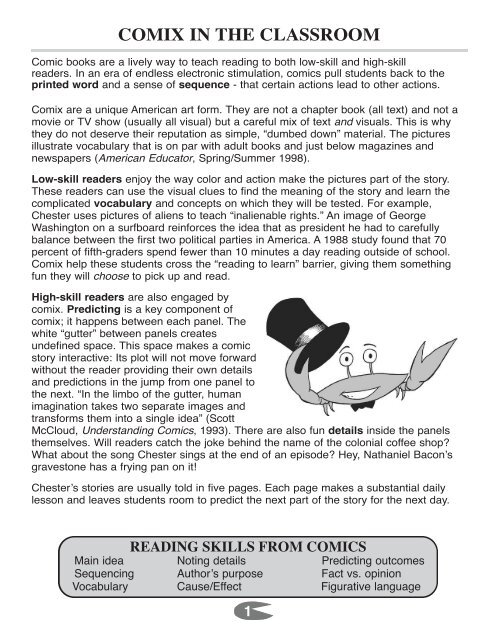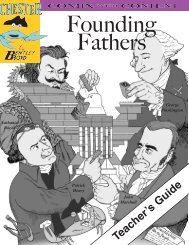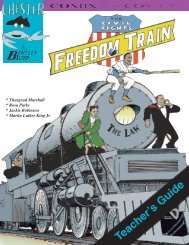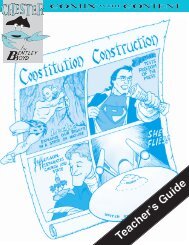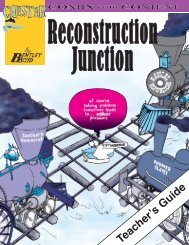Teacher's Guide - Chester Comix
Teacher's Guide - Chester Comix
Teacher's Guide - Chester Comix
Create successful ePaper yourself
Turn your PDF publications into a flip-book with our unique Google optimized e-Paper software.
COMIX IN THE CLASSROOM<br />
Comic books are a lively way to teach reading to both low-skill and high-skill<br />
readers. In an era of endless electronic stimulation, comics pull students back to the<br />
printed word and a sense of sequence - that certain actions lead to other actions.<br />
<strong>Comix</strong> are a unique American art form. They are not a chapter book (all text) and not a<br />
movie or TV show (usually all visual) but a careful mix of text and visuals. This is why<br />
they do not deserve their reputation as simple, “dumbed down” material. The pictures<br />
illustrate vocabulary that is on par with adult books and just below magazines and<br />
newspapers (American Educator, Spring/Summer 1998).<br />
Low-skill readers enjoy the way color and action make the pictures part of the story.<br />
These readers can use the visual clues to find the meaning of the story and learn the<br />
complicated vocabulary and concepts on which they will be tested. For example,<br />
<strong>Chester</strong> uses pictures of aliens to teach “inalienable rights.” An image of George<br />
Washington on a surfboard reinforces the idea that as president he had to carefully<br />
balance between the first two political parties in America. A 1988 study found that 70<br />
percent of fifth-graders spend fewer than 10 minutes a day reading outside of school.<br />
<strong>Comix</strong> help these students cross the “reading to learn” barrier, giving them something<br />
fun they will choose to pick up and read.<br />
High-skill readers are also engaged by<br />
comix. Predicting is a key component of<br />
comix; it happens between each panel. The<br />
white “gutter” between panels creates<br />
undefined space. This space makes a comic<br />
story interactive: Its plot will not move forward<br />
without the reader providing their own details<br />
and predictions in the jump from one panel to<br />
the next. “In the limbo of the gutter, human<br />
imagination takes two separate images and<br />
transforms them into a single idea” (Scott<br />
McCloud, Understanding Comics, 1993). There are also fun details inside the panels<br />
themselves. Will readers catch the joke behind the name of the colonial coffee shop<br />
What about the song <strong>Chester</strong> sings at the end of an episode Hey, Nathaniel Bacon’s<br />
gravestone has a frying pan on it!<br />
<strong>Chester</strong>’s stories are usually told in five pages. Each page makes a substantial daily<br />
lesson and leaves students room to predict the next part of the story for the next day.<br />
READING SKILLS FROM COMICS<br />
Main idea Noting details Predicting outcomes<br />
Sequencing Author’s purpose Fact vs. opinion<br />
Vocabulary Cause/Effect Figurative language<br />
1


